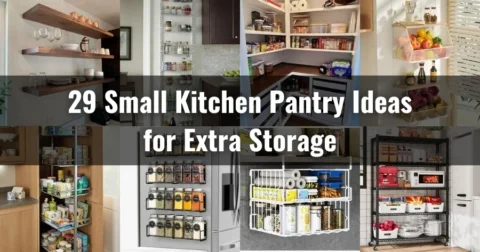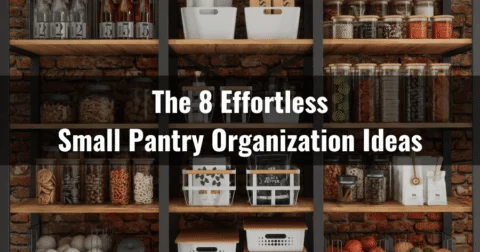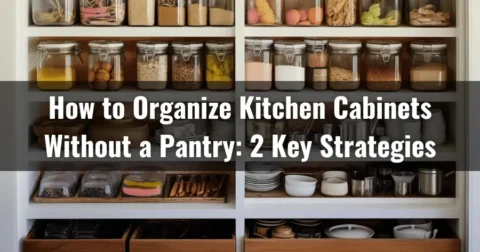Butlers pantry and scullery are iconic features of kitchen design with historical roots, offering distinct functionalities to elevate your culinary experience.
While both spaces aim to provide additional storage and practical solutions for handling kitchen tasks, they differ in size and layout.
A butler’s pantry typically serves as a storage zone with a small preparation area, historically used for serving formal meals and drinks.
On the other hand, a scullery is a separate kitchen area, larger in size, designed for cleaning, washing, and additional storage. There are also other differences between a butlers pantry and a scullery.
We will explore the key differences between these two kitchen spaces, highlighting how they cater to different lifestyles and requirements. Let’s look at the unique features of each, helping you decide what’s best for your ideal kitchen setup.
Differences Between Butlers Pantry vs Scullery

Butler’s pantry and Scullery differ in several categories. The following are among them:
- Purposes and Functionality
- Size and Layout
- Appliances and Amenities
- Concealment and Design
- Cost and Luxury Aspect
Let’s see the difference between the butler’s pantry and the scullery in these categories.
1. Purposes and Functionality
A butler’s pantry consists of a storage area and a small preparation area for serving and prepping meals. Its historical use was for the butler to prepare and serve formal meals and drinks in grand households.
You can store tableware, silverware, glasses, napkins, and other dining essentials in it. Here you will often find features like mini-fridges, coolers, and small appliances. When entertaining, it provides a place to hide dishes and other messes from the main kitchen.
Contrary to this, the scullery is a separate area of the kitchen used for washing, cleaning, and storing stuff. Its historical use was for scullery maids to wash dishes and clean up after meals.
In a scullery, you’ll find features like extra-large sinks, plenty of countertop space, open shelving, and large storage cupboards.
2. Size and Layout
The size and layout of a butler’s pantry and scullery also differ. A butler’s pantry is typically smaller in size compared to a scullery.
It may be designed as a nook or alcove by the kitchen and dining area. This makes it an aesthetically pleasing addition to the home that’s perfect for serving guests and storing food essentials.
Conversely, a scullery is larger in size compared to a butler’s pantry. It’s often located adjacent to the main kitchen but not visible from other parts of the home.
Large families and frequent cooking activities benefit from a scullery’s size, making it perfect for heavy-duty tasks.
3. Appliances and Amenities
The differences in appliances and amenities between a butler’s pantry and scullery are significant. A butler’s pantry usually doesn’t have water outlets, though some have sinks and dishwashers. It usually has basic counter space and cabinetry for storage.
In contrast, a scullery has an extra-large sink and ample space for washing dishes and food preparation.
It may even include a triple-bay commercial sink and two dishwashers to accommodate families with large numbers of members and frequent cooking activities.
A scullery can also store large kitchen appliances and items used infrequently, adding convenience and functionality.
4. Concealment and Design
Concealment and design are where these two spaces often differentiate. Butler’s pantries can be designed as a concealed space with clever cabinetry or a separate door. This design helps to hide messes and dishes from the sight of guests.
Sculleries, in contrast, are often designed as a separate area adjacent to the main kitchen, providing a clean and tidy kitchen area. While both spaces can be hidden from view, sculleries offer a greater sense of separation.
5. Cost and Luxury Aspect
The butler’s pantry is generally less expensive than a scullery due to its smaller size and requirement for fewer materials. Despite that, it still adds a touch of luxury and style to the kitchen design.
Meanwhile, the scullery is more expensive because it’s bigger and requires more materials. It is considered a modern-day luxury and adds class and grace to the home’s design.
Butlers Pantry vs Scullery – Who Are the Ideal Users and What Home Types Suit Each Addition?
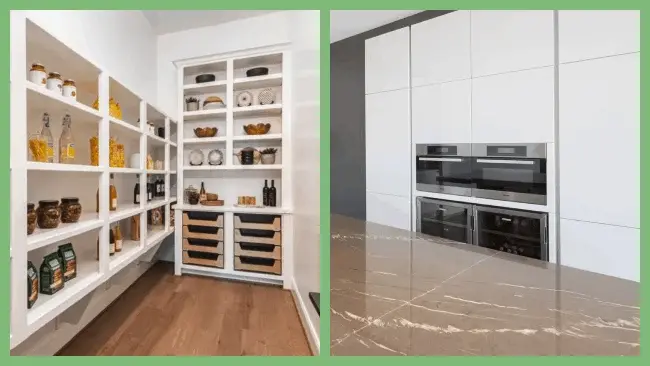
We found that both the butler’s pantry and scullery cater to specific user preferences and home types. Here’s a quick overview:
Ideal Users for Butler’s Pantry:
- People who frequently host formal dinners and gatherings.
- Those who value organized storage for dinnerware, glassware, silverware, and dining essentials.
Home Types that Suit a Butler’s Pantry:
- Homes with a focus on luxury and upscale aesthetics.
- Houses where formal entertaining is a common occurrence.
- Kitchens that are designed to accommodate seamless hosting and dining experiences.
- Residences where space allows for an additional designated area for storage and meal preparation.
Ideal Users for Scullery:
- Individuals who frequently host events, dinners, or gatherings with many people in the kitchen.
- People with a professional cooking background or enthusiastic hobby bakers that need ample food preparation space.
- Those who require extensive storage for cooking equipment, ingredients, and utensils.
Home Types that Suit a Scullery:
- Homes where culinary enthusiasts and professional chefs reside.
- Houses with a focus on functional and efficient cooking spaces.
- Residences where large families or frequent cooking activities demand versatile kitchen areas.
- Kitchens designed to handle substantial meal preparation and storage needs.
Comparison Chart Between Butlers Pantry and Scullery at a Glance:
| Aspect | Butler’s Pantry | Scullery |
| Purposes and Functionality | Serves as a storage zone and a small prep area. | A separate kitchen area for cleaning, washing, and storing stuff. Ideal for entertaining and catering purposes. |
| Stores silverware, dishes, glasses, napkins, and other dining essentials. | Features extra-large sinks, open shelving, and large storage cabinets. | |
| Size and Layout | Typically smaller in size than a scullery. | It’s bigger than a butler’s pantry. Normally situated adjacent to the main kitchen but not in plain view of other parts of the home. |
| Appliances and Amenities | Generally lack water outlets for cleaning up, although some may include a sink and dishwasher. | Equipped with a large sink and ample counter space for preparing food and washing dishes. May feature a three-bay commercial sink and two dishwashers. Can fit big kitchen appliances and stuff you don’t use often. |
| Historical Origins | Historically used in grand households for formal meal preparation and serving. Served as the domain of the household butler. | Historically served as a working area for servants to wash dishes and handle dirty household chores. Found in old English manors and used by downstairs staff. |
| Ideal Users and Home Types | Suitable for those with a passion for hosting formal dinners and gatherings. Ideal for adding a luxurious touch to your home. | Ideal for people who host a lot of events, dinners, or gatherings. Suitable for enthusiastic hobby bakers or those making preserves from homegrown produce. Ideal for families or people with professional cooking backgrounds, as it offers additional kitchen functionality. |
| Concealment and Design | Can be hidden behind clever cabinetry or a separate door. Helps in hiding the mess and dishes away from plain sight. | It’s usually next to the main kitchen, hidden from the rest of the house. Can be hidden from view, providing a clean and tidy main kitchen area. |
| Cost and Luxury Aspect | Generally less expensive compared to a scullery because it uses fewer materials. Gives the kitchen a luxurious feel. | Often more expensive due to the larger size and need for more materials. Modern luxury, it adds grace and class to the home’s design. |
Frequently Asked Questions
There are some questions that people ask regarding the butler’s pantry and scullery. So, here are some FAQs with proper answers that might be helpful for you.
What is the best size for a scullery?
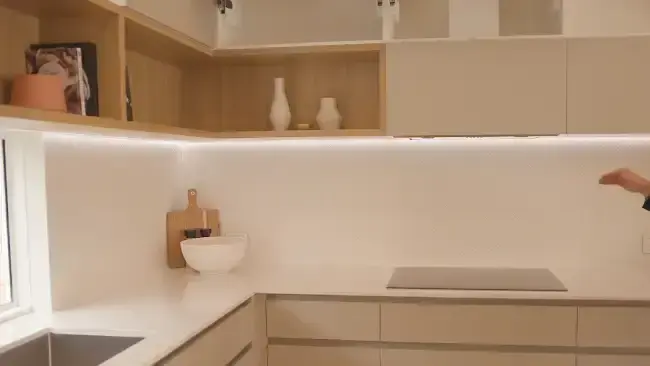
The ideal size for a scullery is typically around 3m x 2m (approximately 10 ft x 6.5 ft). This provides ample space for tasks such as dishwashing, food preparation, and general cleaning.
But, if you have more space at home, you could expand your scullery to a size of 3m x 3m. With a larger scullery, storing kitchen supplies and appliances becomes easier, moving around freely while performing tasks and managing mess and clutter.
Should the microwave go in the butlers pantry?
With these conveniences in mind, placing the microwave in the Butler’s Pantry can be a practical and efficient choice. Doing so lets you keep the main kitchen area tidy and free from clutter, allowing for a more streamlined and organized space.
So, if you value a clean and well-organized kitchen and seek to maximize the functionality of your Butler’s Pantry, placing the microwave in this space could be a beneficial option.
Can a scullery and a butler’s pantry be combined?
A scullery and a butler’s pantry can be combined in a kitchen design. We found that some homeowners choose this approach to create a versatile and elegant space that serves multiple functions.
By combining the two, they can have a beautiful area to store their fine china and silver and everyday dishes.
Also, the combined space can function as a practical area for cooking and washing up, which can be closed off and hidden from guests during formal dining.
This integration becomes easier; large mobility allows for efficient organization and utilization of your kitchen area. It provides both a stylish display for your dining essentials and a practical workspace for various kitchen tasks.
It’s a smart and sophisticated way to make the most out of your kitchen while keeping it organized and aesthetically pleasing.
Conclusion
You now have a clear understanding of the key differences between a butler’s pantry and a scullery. Each iconic kitchen space offers unique advantages, catering to different lifestyles and requirements.
If you enjoy hosting formal dinners and desire an elegant look for your kitchen, the butler’s pantry is the perfect addition. Alternatively, the scullery is a great choice if you often host gatherings and require a versatile area for meal prep and storage.
Ultimately, the decision rests on your lifestyle, preferences, and the specific needs of your household. Both options add functionality and luxury to your kitchen, elevating your culinary experience.



